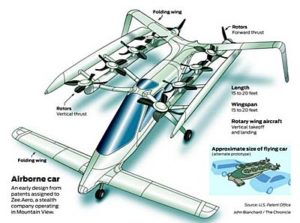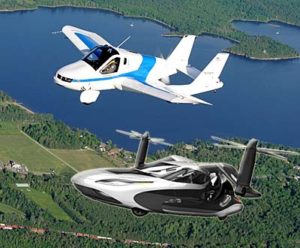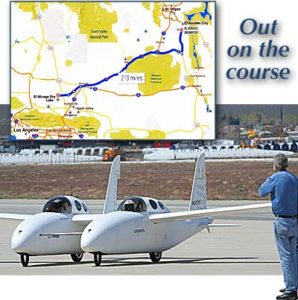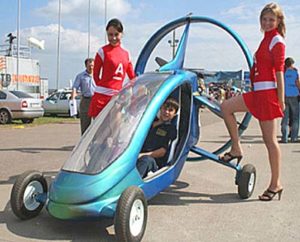If my title confuses you, regrets. The two are related in my mind but not in present-day fact. Nonetheless, I found both interesting and hope you do, too.
First, the fact. Terrafugia, of current Transition Roadable Airplane or flying car fame, won a weight exemption up to 1,800 pounds. This blows past the 1,680 pound exemption won by Icon Aircraft for their A5 LSA seaplane (only 1,510 pounds of which they chose to use). Earlier Terrafugia was granted an exemption to the seaplane LSA weight of 1,430 pounds but that didn’t prove to be enough.
A problem, perhaps the major problem, for Terrafugia is contained in the Federal Motor Vehicle Safety Standards (and let’s be just as government as we can be to go with the inescapable abbreviation of FMVSS). You cannot take to the air with any airplane heavier than an ultralight vehicle (254 pounds empty plus certain exceptions) without satisfying lengthy FAA regulations and you cannot put a non-kit car on the road without meeting the considerable requirements of FMVSS. OK, in truth you can’t go in the air with an aircraft weighing more than a few pounds, provided that aircraft is a drone, but that’s a whole other story of growing federal regulatory intrigue.
After reviewing nearly 300 comments, most of which were supportive, FAA granted Terrafugia a gross weight increase to 1,800 pounds (819 kg) and a stall speed increase to 54 knots (…because Terrafugia argued that increasing the wing size to stay at the LSA standard 45 knots was not feasible for a conforming roadworthy vehicle). So, good for Terrafugia. They can now continue developing Transition, even while pondering their dreamier TFX, that is electric powered, semi-autonomous, and VTOL.
Terrafugia was not, however, aware of an event to which the organizer claims to have invited them. Transition design team leader Carl Dietrich wrote, “I don’t recall hearing of a “Flying Car Racing” event, but if we were invited, we would almost certainly decline — as much fun as it may be — because our focus needs to be on other things plus Transition isn’t designed for racing. I would design a very different vehicle for racing if there was a customer for it.
You can go to the Flying Car Racing website and draw your own conclusions but I must admit this is mildly interesting to me. As I replied to Carl, “I don’t see it so much actual racing as capabilities demonstration. Who knows? It may never happen. They’re talking about an event in 2017 though I’ll give them points for at least planning well ahead. On the other hand, it could generate considerable media interest, I suppose.”
Most of what the organizers show is a gathering of anything and everything that might remotely be considered a “flying car.” They get more points for finding quite a few candidates but miss some obvious ones, for example, the recently Special LSA approved SkyRunner (video) though that is more off-road than roadable, but who wants to split hairs?
Have I wandered out of the solar system in exploring this topic? Maybe, but it has to do with the types of aircraft normally covered on this website and it could be a media generator (already has been to some extent) so I thought I’d look into it. If it continues to be something, I’ll follow up. If it fizzles, well, hopefully you enjoyed looking at it with me.
Flying Car Racing is developed in — where else? — Los Angeles, California. The first invitational is planned for 2017, they stated.
Here are the teams they invited. Some of these entries intend to be “flying cars.” Others are simply vehicles you could drive around on the ground (sort of) with wings atop their carriages.
Three categories have been established: Radio-controlled, Electric, and Unlimited. Organizers note, “Entrants must be able to operate their flying cars legally on the ground and in the air between El Mirage Dry Lake, California and Boulder City, Nevada, USA.” They add, “Vehicles that are not street legal may race in restricted trials on and above El Mirage Dry Lake, California. Radio-controlled flying cars will be raced within visual range of a control area on land and in the air.” The latter seems in keeping with FAA current insistence on line-of-sight control of airborne drones. No word if FMVSS has an opinion, but they may weigh in later.
The RC group is defined as “Unmanned and human-guided in real-time,” while the Electric category is “Manned with electric drive.” Unlimited or “manned” types include I-Tec’s Maverick (video), Terrafugia’s Transition (video), AeroMobile 3.0, the old Molt Taylor Aerocar, Caravellair, PAL-V, the greatly modified Sportsman PlaneDriven PD-1; Scarab Aviation’s Evolution, the telescoping wing Sampson, and Zee Aero’s flying taxi (or whatever it is; they’re being very quiet).

Shown: artwork for Zee Aero’s project about which the company is saying almost nothing beyond Google leader Larry Page’s involvement. This image was modified from patent application drawings.
Of course, the whole thing could lose energy as did the once-heralded Rocket Racing League. No teams I contacted had committed to attending. In fact, they didn’t even know about it so this could be no more than an overhyped dream. Yet, the concept is rather cool, I think, and it would indeed begin to separate the men from the boys by asking all competitors to travel 219 miles. That’s hardly an insurmountable distance for any credible entry but reliability could be a challenge for the less developed projects.
Groups like Terrafugia, I-Tec, and Aeromobile have flown their machines and driven them on roads. Heck, a Maverick traveled by road all the way from Florida to Oshkosh one year. So a 219 trip would be child’s play for some but the more questionable entries might not go the distance. I should think a 219-mile trip by radio-controlled model would be rather tiresome.
Then again, anything’s possible and this just might make the mainstream media sit up and pay attention. MSM reporters seem to love driverless cars, so who knows? I say, anything that paints aviation and flying in a good light is probably worthwhile. So… gentlemen, start your engines and spin your props. Boogity, boogity, boogity! Let’s go racing!





Leave a Reply